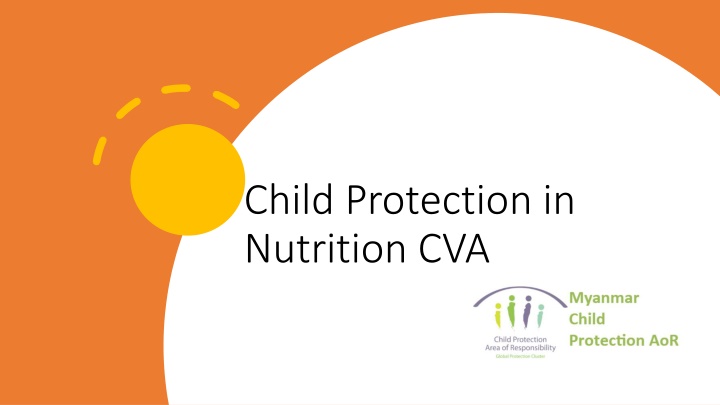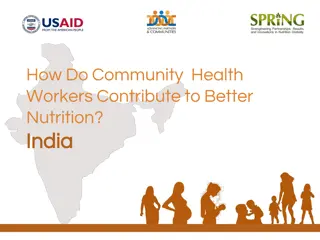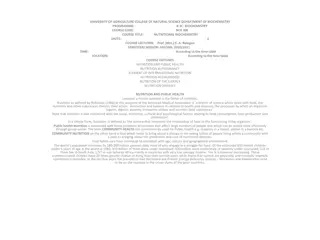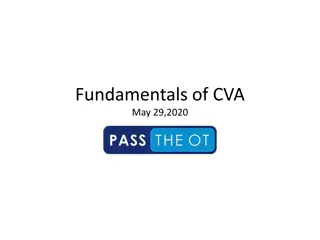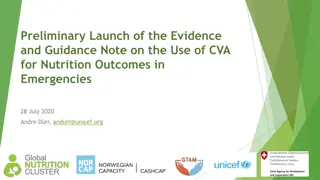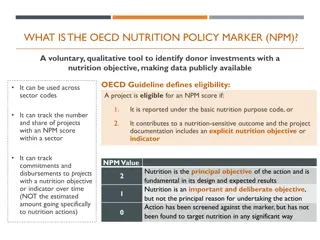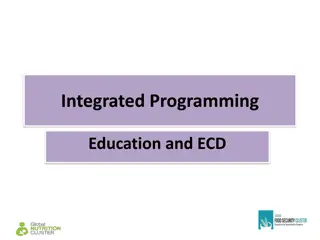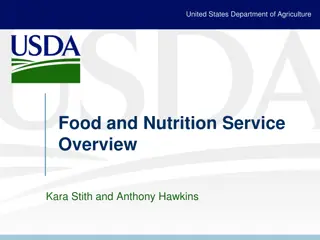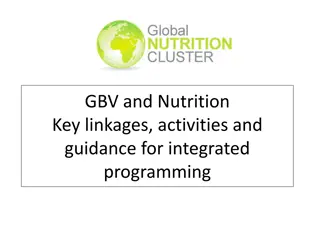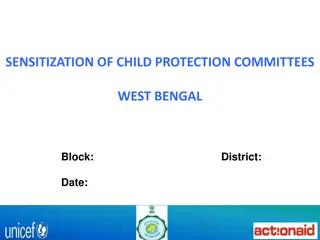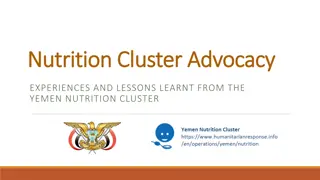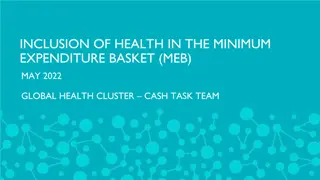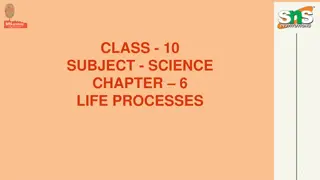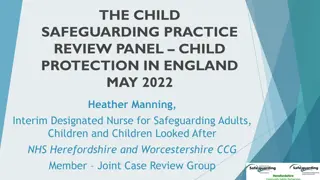Child Protection in Nutrition CVA
Mainstreaming child protection within humanitarian responses is crucial in addressing risks of exploitation, abuse, and violence during crises like in Myanmar. By integrating protection concepts into various sectors and programs, actors can better ensure the safety, dignity, and empowerment of vulnerable individuals. Key elements include meaningful access, safety, dignity, no harm, participation, empowerment, and accountability. Factors such as ensuring safe and accessible facilities, staff training on protection protocols, and maintaining confidentiality are essential to prevent harm and promote well-being, especially for children, women, and girls.
Download Presentation

Please find below an Image/Link to download the presentation.
The content on the website is provided AS IS for your information and personal use only. It may not be sold, licensed, or shared on other websites without obtaining consent from the author.If you encounter any issues during the download, it is possible that the publisher has removed the file from their server.
You are allowed to download the files provided on this website for personal or commercial use, subject to the condition that they are used lawfully. All files are the property of their respective owners.
The content on the website is provided AS IS for your information and personal use only. It may not be sold, licensed, or shared on other websites without obtaining consent from the author.
E N D
Presentation Transcript
Child Protection in Nutrition CVA
Why mainstream? Myanmar is in its essence a protection crisis Humanitarian response can have unintentional harmful impacts if we do not proactively mainstream Child Protection and GBV are exacerbated in a crisis Cash and Voucher activities can unintentionally make GBV or CP issues worse if risks are not considered and actions taken to ensure do no harm
To identify persons of concerns with specific needs: Risk of exploitation, abuse, violence, neglect Specific categories of vulnerable persons: persons with disabilities, pregnant woman, single woman, older persons, children. Toprevent the causes and consequences of violence and abuse To reduce vulnerability and strengthen the capacity of at-risk individuals and populations To strengthen the protective environment Protection in practice
Why Mainstreaming? seeks to address a certain problem or contribute to a certain outcome without creating a new program sector for it ...integrates protection concepts into other sectors or programs By mainstreaming protection, actors can support people to safely access and enjoy their rights and humanitarian services Joint Capacity Sharing Initiative RRRC
Key Elements of Protection Mainstreaming Meaningful Access Safety, Dignity, No Harm Participation & Empowerment Accountability
Factors Factors DO NO HARM DO NO HARM Ensure that facilities are in a safe, accessible place for everyone (consider women collecting distributions they not be forced to take risks to receive services) Ensure you have a plan for people who will be waiting, so that crowds and lines can be managed fairly and safely for all. Ensure that all staffs and volunteers have training on PSEA and applicable Code of Conduct protocol which includes GBV and CP. Maintain confidentiality of all cases to avoid stigmatization or unwanted attention even within families, ensure that confidentiality is respected Ensure transparent, understandable information shared with all so they can take informed decisions Think about these factors in relation to children, women and girls
Key factors in mainstreaming protection A mainstreaming approach seeks to incorporate a concept or principle throughout the program cycle. It aims to enhance existing work within clusters, rather than creating new clusters. Protection mainstreaming is The process through which fundamental human rights principles are recognized and realized in program design and implementation . Including concrete steps to mitigate GBV and CP Through adopting Protecting and Promoting Rights as a programming principle in the Program Framework, Protection Cluster and AoRs has made a commitment to mainstreaming protection and all have a role to play in this.
Today we will focus on CP
Protection Protection Mainstreaming Mainstreaming Training Module: Training Module: Child protection Child protection
What is Child Protection? Introduction to the concept in humanitarian action
Brainstorm ideas 5 5 minutes minutes plenary discussion
Child Protection definition Prevention and Response to Exploitation, Violence, Abuse and Neglect (EVAN) Note it is a sub-set of Child Rights Under the Convention of the Rights of the Child we don t look at all rights but specifically EVAN
Child Protection Child Protection Risks were already prevalent in our context Child Protection Concerns Increase Violence against Children (including notable rise violence in the home and SGBV) Increase Child Marriage Increase Child Labour Lost and missing children Recruitment to armed forces Arbitrary arrest Dangers and injuries Increase exposure to trafficking and smuggling Psychosocial distress and anxiety Conflict and political situation, and covid have exacerbated these Child Protection concerns It is therefore of utmost importance that ALL sectors place child protection at center of their programs
Who is a child and why mainstream child protection? A child is anyone under the age of 18 To mainstream child protection means to ensure child protection considerations inform all aspects of humanitarian action. It also minimizes the risks of children being violated by programs designed without proper consideration for children s safety or wellbeing. Mainstreaming child protection is an essential part of compliance with the do no harm principle that applies to all humanitarian action Mainstreaming is proactive as most harm is unintentional but child protection mainstreaming requires dedicated consideration of risks and mitigation of these risks
DISCUSSION DISCUSSION 10 minutes How could a program put children at risk unintentionally List ways that Nutrition Cluster could unintentionally cause harm to children or place them at risk through CVA
Child safety in crowd control measures Waiting Time for adolescents picking assistance/scheduling Gender issues in distribution Think about possible risks for CVA Missing cards/ration cards and measures of handling Vulnerable families needing additional assistance, how? What measures? Access to information prior, during and after distribution Post distribution monitoring for CHH and vulnerable families missing children occurring at distribution points ( recurrently), Road traffic accidents, Having child space for mother coming at the distribution points with underage children
How can we mainstream Child Protection? Some tools and tips
How to Mainstream Child protection Involve children in design, implementation and monitoring of the project/program Ask children (with support of CPO) so you can identify the risks through children s eyes Identify risks your program may have on children Use a risk matrix and identify all possible scenarios that children may encounter as well as how you will mitigate them.
How to Mainstream Child protection Be accountable to children Work with CP actors to ensure children understand the program and how they can provide feedback if unexpected negative impact Are you enhancing protective environment for children Write down one way your program enhances protective environment ( think about parents, friends, community) Our role is not to replace protective environment but to support it
Remember! In emergencies, girls and boys face increased risk to violence, abuse, neglect and exploitation. The way in which humanitarian aid is delivered can further increase these risks. This is usually unintentional so we must ensure that adequate consultation with children and families is undertaken at all phases Many threats to the safety and wellbeing of children can be mitigated or even eradicated through timely and sensitive provision of humanitarian aid across all sectors. Ask CP actors if in doubt!!
Mainstreaming Child Protection Is the responsibility of ALL actors and mandatory for humanitarian response
Child Protection minimum standards in Humanitarian Action https://alliancecpha.org/en/CPMS_home
Cash and Voucher Assistance Evidence still developing Impact of CVA o the well-being and protection of children, including adolescents must be provided when designing interventions Without discrimination (e.g. lack of birth registration or other identity document should not be a barrier) Risk assessment should be undertaken to mitigate potential risks
Child Protection and Nutrition standard 25 standard 25 page 265 The standard: Children and their caregivers, especially pregnant and lactating women and girls, have access to safe, adequate and appropriate nutrition services
CPMS supports you with following structure Introduction The Standard Key actions for Child Protection and Food Security actors to work together Key actions for Child Protection actors Key actions for Food Security actors Measurement Guidance Notes
%of identified health facilities and nutrition feeding centres that accept referrals of children in need of special services %of supplementary or therapeutic feeding centres with at least one focal point rained on child protection.
